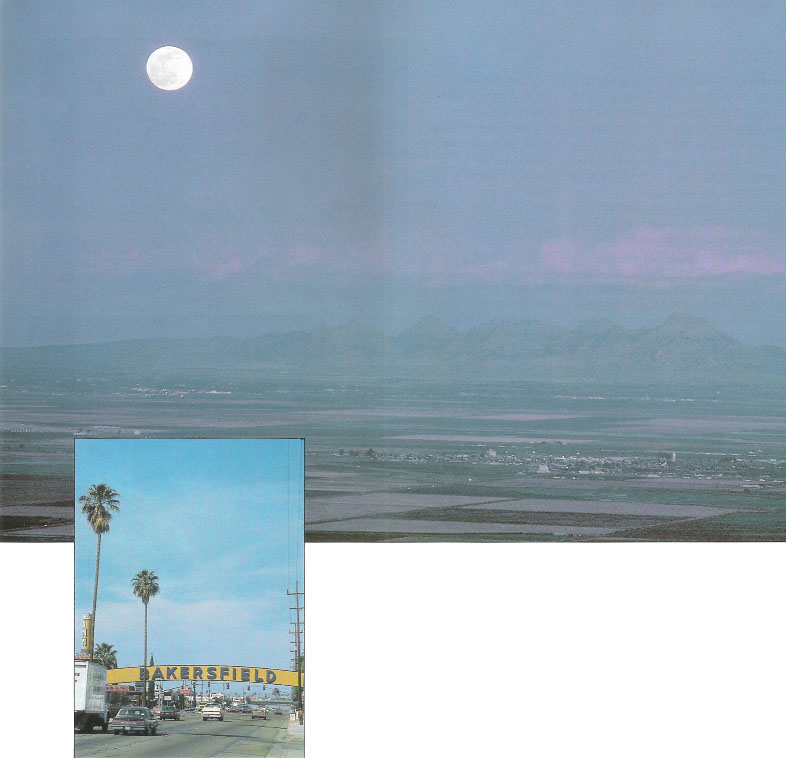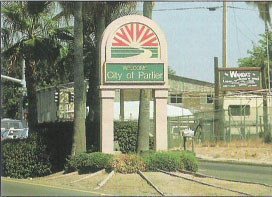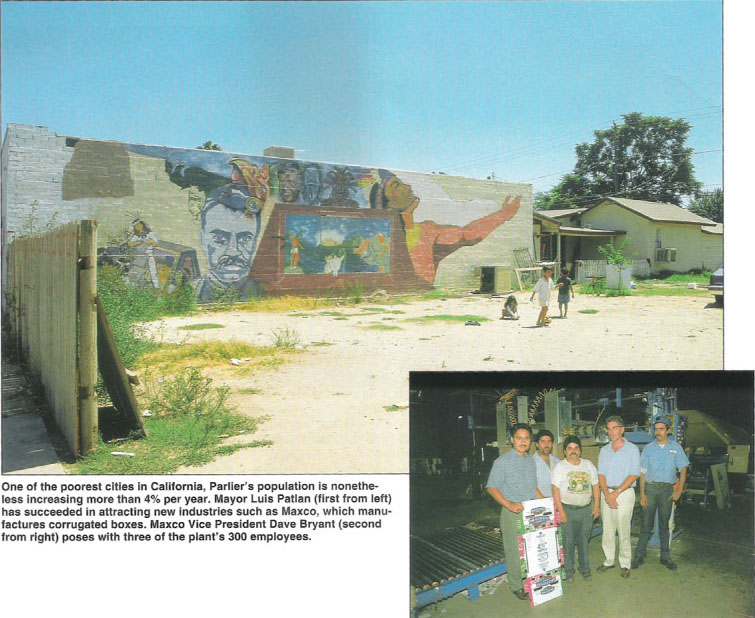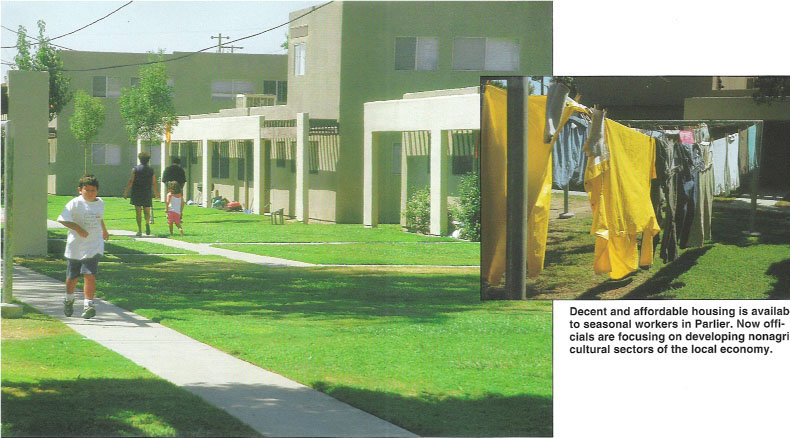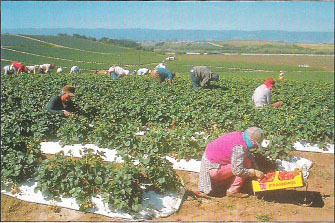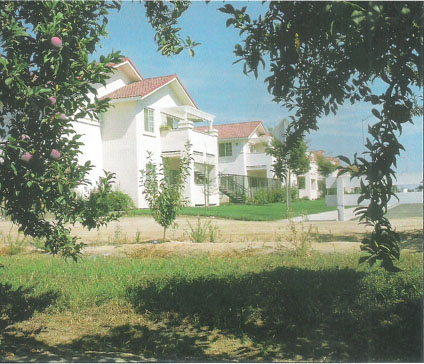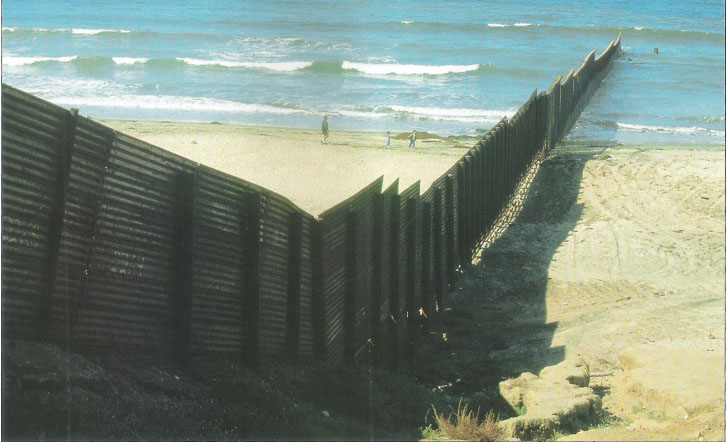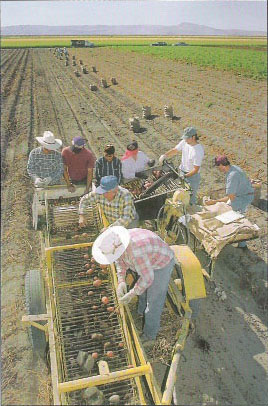All Issues
The new rural poverty: Central Valley evolving into patchwork of poverty and prosperity
Publication Information
California Agriculture 54(1):26-32. https://doi.org/10.3733/ca.v054n01p26
Published January 01, 2000
PDF | Citation | Permissions
Abstract
From Redding to Bakersfield, the Central Valley is evolving into a patchwork of poverty and prosperity. Despite being part of the world's most prosperous agricultural economy, more than 25% of Fresno County's 800,000 residents were eligible for Medi-Cal in 1998. A study of 65 rural California towns indicates that labor-intensive agriculture contributes to poverty and welfare demands in rural communities by attracting large numbers of unskilled foreign workers and offering most of them poverty-level wages. In the 65 towns, 28% of the residents live in households with below-poverty incomes. Major policy choices for ameliorating this situation include modifying immigration and labor laws that affect farming to help farmworkers earn higher wages.
Full text
Despite agricultural abundance, poverty is widespread in many Central Valley towns. Photo by Phil Schermeister.
One of the poorest cities in California, Parlier's population is nonetheless increasing more than 4% per year. Mayor Luis Patlan (first from left) has succeeded in attracting new industries such as Maxco, which manufactures corrugated boxes. Maxco Vice President Dave Bryant (second from right) poses with three of the plant's 300 employees.
Parlier, a city of 10,400 about 20 miles southeast of Fresno, lies in the heart of the area that produces most U.S. table grapes, raisins and wine grapes, and tree fruits such as peaches and nectarines. In 1990, 86% of the population was Hispanic, and more than two-thirds of the local work force in the summer consisted of foreign-born farmworkers. The job pyramid is very steep, with a broad base of low-paying, seasonal jobs and only a few stable jobs at the top. The best jobs are in government, where wages are not influenced by local conditions. The second-best jobs are in the farmworker service economy, providing migrant and seasonal workers with housing, rides to work, meals and other services, often for cash in an underground economy. Most people are poor, but the receipt of welfare benefits is uneven, since many local residents, especially immigrants, are not eligible.
Despite being part of the world's most prosperous agricultural economy, Parlier is one of the poorest five cities in California, measured by the percentage of residents living below the poverty line. Paradoxically, its population is growing by more than 4% per year, as rural Mexicans see more opportunity in rural California than at home. Most immigrant farmworkers currently drift out of seasonal harvesting jobs after 10 to 15 years, and their children educated in the United States are unlikely to work the fields (Taylor et al. 1996).
Parlier is not unique; it typifies the challenges confronting California's rural communities at the start of the new millennium. The statistical findings presented below indicate that from Redding to Bakersfield, the Central Valley is evolving into a patchwork of poverty and prosperity, not into an economy that offers upward mobility to all residents. If current growth patterns persist, the landscape of inequality in rural California will become more pronounced in the future, as labor-intensive agriculture, fueled by immigration, produces profits on one side and poverty for farmworkers on the other.
Decent and affordable housing is available to seasonal workers in Parlier. Now officials are focusing on developing nonagricultural sectors of the local economy.
Population growth and poverty
When population and economic changes come together in agricultural areas, the usual challenge is to create enough good jobs for residents. The challenge is especially acute in the 450-mile-long, 75-mile-wide Central Valley. California's total population is projected to increase by 50% over the next 25 years ( see p. 11 ). The population of the Central Valley, which numbered about 3 million in 1970, is expected to almost double to 6 million by 2000 and then to double again by 2025.
The Central Valley is often subdivided into three subregions:
-
The Sacramento region (2 million residents), dominated by government and increasingly high-tech manufacturing and services.
-
The northern Sacramento Valley (600,000 residents), with an economy based on agriculture and natural resources.
-
The San Joaquin Valley (3.4 million residents), based on agriculture.
Future interactions of demographic and economic change affecting agriculture are likely to be most apparent in the San Joaquin Valley, which has the most productive agricultural system in the world but also two of the four poorest large U.S. metropolitan areas (population of 500,000 or more), Fresno and Bakersfield. Poverty is defined as the percentage of residents living in households with incomes below the poverty line ($16,000 for a family of four in 1997). Socioeconomic indicators for the San Joaquin Valley illustrate the challenge: about 30% of the adults have not finished high school, and 25% of the children in the Valley live in families with below-poverty-level incomes (California Department of Finance 1998).
Rapid population growth in the San Joaquin Valley is due to three major factors: immigration; high fertility, especially among immigrant women; and spillover population growth from the Bay Area and Los Angeles, including a growing commuter population in search of affordable housing.
Fresno County, the 10th most populous county in California, is the top-producing agricultural county in the United States in terms of value. But more than 25% of its almost 800,000 residents were Medi-Cal-eligible in 1998 (compared with 15% for California as a whole), and more than 12% received Aid for Families with Dependent Children/Temporary Assistance for Needy Families (AFDC/TANF) cash assistance (compared with 6.5% for California). Unemployment averaged 12% (versus 6% for all of California), yet farmers complained of labor shortages (Martin and Nyberg 1999). The status quo, in the view of many observers, risks the creation of a new rural poverty, as poor Mexicans migrate to agricultural areas where they have low earnings and limited mobility.
About 55% of the immigrants who arrived in the San Joaquin Valley between 1980 and 1990 were from Mexico (another 25% were from Southeast Asia). A combination of little education, low earnings from seasonal farm employment, and large households gave San Joaquin Valley immigrants from Mexico who entered the United States during the 1980s incomes of $3,700 per person in 1990. That is about the same as the per capita income of Mexico but higher than the per-capita income of rural Mexico, where most of these immigrants originate (unreported income may be substantial, both in the United States and in Mexico).
Immigration, poverty and welfare
Immigrants in the 1980s and 1990s encountered a different California economy and labor market than those entering in previous decades. The emergence of the new information and technology-based economy means that now, more than ever before, education and skills are the prerequisite for economic mobility. These are precisely the characteristics most immigrants and many immigrant children in rural California lack.
The farm labor market also has changed. In the 1960s, after the termination of the bracero labor-recruitment program between the United States and Mexico, labor scarcity opened the door to unionization and rising real wages for California farmworkers. These economic advances for farmworkers were reversed in the 1980s and 1990s, as an elastic (highly responsive) supply of low-skilled labor from Mexico and a proliferation of farm labor contractors created surplus labor conditions ( see p. 19 ).
Today, California farmworkers face not only declining real earnings but also a lack of housing and other benefits many once enjoyed. For these workers, real take-home earnings, after housing costs, have fallen substantially in the last two decades. Instead of living on the farms where they work, impoverished farmworkers and their families crowd into small rural towns, creating a new concentrated poverty there.
We used 1990 Census data on immigration, poverty and welfare in 65 rural California towns — containing a total population of 450,840 — to test the hypothesis that labor-intensive agriculture, by attracting large numbers of unskilled foreign workers and offering most of them poverty-level earnings, contributes to poverty and welfare demands in rural communities. Our sample included all incorporated municipalities with fewer than 20,000 inhabitants and at least 8% of their labor force employed principally in agriculture. Most of the communities in our study are located in the San Joaquin Valley, such as Parlier, McFarland and Huron.
Past research on economic impacts of immigration have focused on urban areas and considered only the oneway relationship between immigration and such variables as wages and unemployment rates. In contrast, we adopted an interactive approach, looking at how immigration both influences and is influenced by farm employment and tracing through the impacts on poverty and welfare use in rural towns (Martin and Taylor 1998).
The 65 farmworker towns in our study are small and poor. In these towns, 28% of the residents live in households with below-poverty incomes. Twenty-nine percent are foreign-born, and one-third of the foreign-born arrived during the 1980s. Labor-force participation is relatively low — an average of 36% are employed or looking for work. (By comparison, about half of the U.S. and California populations are employed or looking for work.) About one-third of the typical city's labor force is employed in agriculture, down from 50% in 1980. However, during the 1980s, the absolute number of people in farm jobs expanded by 17% in the average sample city (the share of labor force in agriculture fell because the number of people in nonfarm jobs increased more rapidly than the number in farm jobs).
Our simultaneous-equation regression analysis (see study methods below) uncovered a positive relationship between farm employment and both immigration and poverty. Other things being the same, a 100-person increase in farm employment was associated with 139 more people living in poverty during the 1980s. That is, the poverty multiplier of an additional farm job was 1.39. Farm employment increased poverty both directly, by offering farmworkers below-poverty earnings, and indirectly, by stimulating immigration of people with few skills.
Study methods
Simultaneous-equation regression analysis is widely used to estimate economic relationships involving more than two dependent variables (we attempt to explain the behavior of dependent variables with the model). In these cases, a regression equation is specified for each of the dependent variables. Our model has five dependent variables: immigration (the change in a community's foreign-born population between 1980 and 1990); the number of people living in impoverished households; the number of people in households with welfare income; the number employed in farm jobs; and the number in nonfarm jobs. These dependent variables are functions of independent variables (community population, foreign-born population, farm and nonfarm employment, and poverty at the start of the 1980 to 1990 period, etc.) as well as of each other (e.g., welfare use is a function of poverty; immigration is a function of farm employment and farm employment is a function of immigration; poverty is a function of immigration and of both farm and nonfarm employment). Because the dependent variables are all potentially interrelated, the five equations are not estimated independently, but rather as a system, using the three-stage, least-squares method.
—J.E.T.
The farm employment-immigration link was circular. Farm employment drew immigrants into rural towns, and immigration in turn relaxed the labor constraint on the expansion of labor-intensive agriculture, leading to the creation of additional farm jobs. Our findings show that each 100-person increase in foreign-born population added 37 more workers to farm payrolls during the decade.
Many residents and nearly all newcomers to these cities are noncitizens ineligible for welfare under the Personal Responsibility and Work Opportunity Reconciliation Act (PRWORA), the 1996 U.S. welfare reform, so there is not a one-to-one relationship between poverty and welfare. A 100-person increase in the number of poor residents was associated with a 57-person increase in the number of welfare recipients. There was no significant direct relationship between immigration and welfare use, which casts doubt on the Proposition 187 argument that immigration is motivated by access to welfare benefits.
The farm employment-poverty-welfare cycle is stronger in California than in the rest of the country, where, on average, agricultural production is less labor-intensive and farmers traditionally have less access to low-skilled immigrant workers. Farm employment reduced poverty in the United States during the 1970s, when farmworker wages rose and unionization was on the upswing. Other things being equal, an additional 100 farm jobs were associated with 43 fewer people in poverty and 52 fewer people in households receiving welfare income. The ameliorative effect of farm employment on poverty reversed in the 1980s: by 1990, an additional 100 farm jobs were associated with a 97-person increase in poverty and a 16-person increase in welfare use. At the same time, the role of immigrant workers, especially unauthorized immigrants, in the U.S. agricultural work force has increased (US Department of Labor 1993).
What does the future hold?
Our research findings suggest that there is a vicious circle of more farm jobs, more immigration and more poverty in rural California. What does this finding portend for California in 2025? How are policy initiatives, including immigration and welfare reforms, likely to reshape the state's rural demographic and social landscape?
California's future includes a vastly more populous San Joaquin Valley and an increasingly complex “rural” economy, as urban sprawl in centers like Sacramento, Fresno and Bakers-field and housing spillover from San Diego, Los Angeles and the Bay Area continue to take over California's fields. City and regional planning policies may alter the sprawl at its margins, but San Joaquin Valley population growth appears to be inevitable.
The range of policy options to reduce farmworker poverty in the next 25 years is bracketed by two extremes. One extreme is the guest worker option, which advocates bringing seasonal farmworkers into the United States in a manner that does not lead to settlement. This implies implementing more effective border controls so that individuals enter the country as guest workers who return home, instead of as unauthorized immigrants who might settle. The other extreme is not to worry about controlling immigration and settlement, but rather to adopt integration policies that uplift poor rural residents, including immigrants and their children, by improving economic mobility. Options in between these two extremes include unionization of the farm work force and better enforcement of labor and tax laws.
The major immigration-related policy initiatives of the 1990s attempted to restrict immigration with increased border enforcement while limiting access to public services through welfare reform.
Some researchers question the ability of border enforcement to control the flow of immigrant workers between Mexico and the United States, in light of a voracious demand for low-skilled labor in the United States and limited employment options in Mexico (Singer and Massey 1998). The Binational Study of Immigration, sponsored by the U.S. Commission on Immigration Reform and the Mexican Foreign Affairs Secretariat, concluded that tighter border enforcement increased, rather than decreased, the number of unauthorized immigrants in the United States during the 1990s. Most who attempt entry into the United States without proper documents ultimately succeed. However, a higher risk of apprehension at the border encourages once-seasonal migrants to remain in the United States throughout the year and raise their families here, creating new public-service demands in California's rural communities ( see p. 11 ).
A USDA survey found that more than half of California's farm laborers during 1998 were unauthorized, despite fences along the U.S./Mexico border south of San Diego.
The Immigration and Naturalization Service (INS) contends that its border enforcement strategy ultimately will prevail, but to date its primary impact has been on where immigrants cross the border, not on the number of individuals who cross (GAO 1999; CIIP 1999). The U.S. Department of Labor's National Agricultural Worker Survey found that 52% of California's farm work force was comprised of unauthorized immigrants in 1998. That is a higher percentage than on the eve of the Special Agricultural Worker program that legalized more than 700,000 California farmworkers — most of the state's agricultural work force — under the Immigration Reform and Control Act of 1986.
National welfare policy, as legislated by the 1996 PRWORA, has placed new restrictions on immigrants' access to welfare benefits ( see p. 35 ). This raises concerns about the economic integration not only of poor immigrants, but poor citizens as well, including the U.S.-born children of immigrants. The Urban Institute estimates that nearly one in 10 American children lives in a mixed-status family with at least one noncitizen parent and one citizen child (Fix and Zimmerman 1999). If welfare reform reduces immigrant families' income, all family members, not only noncitizens, are affected. Moreover, it is not clear whether welfare reform has discouraged noneligible immigrant parents from seeking benefits for their U.S.-citizen children, who are entitled to public assistance regardless of their parents' immigration status. (Our study was conducted using data collected before welfare reform was passed in 1996.)
An overarching goal of PRWORA is to get individuals off of welfare and into the work force. However, there is a mismatch between welfare recipients and jobs in rural California. Virtually all new entrants to the farm labor force are young men who recently arrived from Mexico to do seasonal farm work. They are flexible and willing to travel to different fields each day and work long hours if needed. Most welfare recipients, on the other hand, are mothers with children who lack the flexibility that farm employers have come to expect (Rural Migration News 1997).
The networks linking U.S. farm jobs with new immigrant workers are better established than those linking farm employers with local welfare recipients. The farm labor contractors who hire and supervise at least half of all farmworkers have little incentive to form crews of welfare recipients, who may complain about violations of labor laws that farm labor contractors commit. In the 1990s, there was little evidence of generalized farm labor shortages that would encourage farmers to invest in recruitment and training of welfare recipients or tolerate less-than-stellar work habits (Taylor et al. 1996).
Because of these thorny issues, many local observers are pessimistic about welfare reform's prospects in rural California. Ernest Velasquez, retired Social Services director for Fresno County, says that “the goal of moving people from welfare to jobs in only two years is not realistic in the San Joaquin Valley. I'm not sure how you implement welfare reform in a place with no jobs” (Arax 1997).
Despite the absence of generalized farm labor shortages, California growers are intensifying their push for a guest-worker program at the new millennium. They cite INS claims that border and internal enforcement of immigration laws will eventually succeed in reducing the flow of workers across the border, as well as the reluctance of U.S. citizens to work in the fields. It is likely that the next 25 years will witness new experiments with federal guest-worker programs for agriculture.
Guest-worker programs have a number of strikes against them. First, in practice, they do not prevent immigrants from settling; hence the adage “there is nothing as permanent as a temporary worker.” Second, despite policymakers' best intentions, guest-worker regulations are difficult to enforce in an agricultural economy riddled with immigration and labor-law violations (Martin 1998). Third, some observers bemoan the exclusionary nature of guest-worker policies, which defy the inclusionary ideals that created this “nation of immigrants.” Finally, our analysis suggests that guest-worker programs would leave California's existing rural poverty intact.
The prospects for widespread unionization and significantly increased enforcement of labor laws also appear dim. In the 1960s, Cesar Chavez recognized the difficulty of organizing a foreign-born and constantly changing agricultural work force; he relied heavily on consumer boycotts to promote unionization. Today, fewer than 300 union contracts cover less than 5% of California farmworkers ( see p. 19 ). The political will to enforce agricultural labor laws has waned, and the number of people involved in enforcing California's labor laws decreased in the 1990s due to cutbacks in government funding that have not been restored (Rural Migration News 1996).
Future in focus: The new rural poverty
Technological advances in California agriculture have focused on raising the productivity of land, not labor. This explains the high labor intensity of many farm operations, evident to anyone who observes, for example, a Fresno raisin harvest. Despite California's harvest of plenty, the productivity of individual workers is lower than it would be with more capital-intensive practices. For example, the driver of a tomato harvesting machine harvests far more tomatoes per day than a hand harvester could, and a worker using air-powered tools can prune trees and vines faster than a hand worker. This, together with a ready supply of new immigrants willing to work at low wages, keeps real wages for farmworkers from rising when the demand for field hands increases. The availability of inexpensive and flexible immigrant labor, in turn, discourages farmers and labor contractors from mechanizing and “stretching out” labor demands to provide workers with more stable employment. As a result, California's agricultural prosperity is reflected in the price of land, not labor. Herein lie the roots of California's new rural poverty. As Carol Whiteside, president of the Great Valley Center, put it, “The Central Valley will either wind up as a contributor to the state's economic development or it will wind up as California's Appalachia” (Rural Migration News 1998). If poverty amid prosperity persists, it may end up being both.



